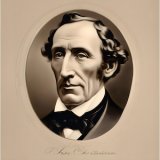The Snow Queen
The Snow Queen is a fantastical tale written by Hans Christian Andersen about two best friends, Kai and Gerda. When Kai is taken by the enchanting yet merciless Snow Queen, Gerda embarks on a journey to rescue him, encountering numerous magical beings and undergoing various tests of character along the way. It is a heartwarming tale of friendship, courage, and the enduring power of love.
IN SEVEN STORIES STORY THE FIRST Which describes a looking-glass and the broken fragments. You must attend to the commencement of this story, for when we get to the end we shall know more than we do now about a very wicked hobgoblin; he was one of the very worst, for he was a real demon. One day, when he was in a merry mood, he made a looking-glass which had the power of making everything good or beautiful that was reflected in it almost shrink to nothing, while everything that was worthless and bad looked increased in size and worse than ever. The most lovely landscapes appeared like boiled spinach, and the people became hideous, and looked as if they stood on their heads and had no bodies. Their countenances were so distorted that no one could recognize them, and even one freckle on the face appeared to spread over the whole of the nose and mouth. The demon said this was very amusing. When a good or pious thought passed through the mind of any one it was misrepresented in the glass; and then how the demon laughed at his cunning invention. All who went to the demon's school--for he kept a school--talked everywhere of the wonders they had seen, and declared that people could now, for the first time, see what the world and mankind were really like. They carried the glass about everywhere, till at last there was not a land nor a people who had not been looked at through this distorted mirror. They wanted even to fly with it up to heaven to see the angels, but the higher they flew the more slippery the glass became, and they could scarcely hold it, till at last it slipped from their hands, fell to the earth, and was broken into millions of pieces. But now the looking-glass caused more unhappiness than ever, for some of the fragments were not so large as a grain of sand, and they flew about the world into every country. When one of these tiny atoms flew into a person's eye, it stuck there unknown to him, and from that moment he saw everything through a distorted medium, or could see only the worst side of what he looked at, for even the smallest fragment retained the same power which had belonged to the whole mirror. Some few persons even got a fragment of the looking-glass in their hearts, and this was very terrible, for their hearts became cold like a lump of ice. A few of the pieces were so large that they could be used as window-panes; it would have been a sad thing to look at our friends through them. Other pieces were made into spectacles; this was dreadful for those who wore them, for they could see nothing either rightly or justly. At all this the wicked demon laughed till his sides shook--it tickled him so to see the mischief he had done. There were still a number of these little fragments of glass floating about in the air, and now you shall hear what happened with one of them. SECOND STORY A LITTLE BOY AND A LITTLE GIRL In a large town, full of houses and people, there is not room for everybody to have even a little garden, therefore they are obliged to be satisfied with a few flowers in flower-pots. In one of these large towns lived two poor children who had a garden something larger and better than a few flower-pots. They were not brother and sister, but they loved each other almost as much as if they had been. Their parents lived opposite to each other in two garrets, where the roofs of neighboring houses projected out towards each other and the water-pipe ran between them. In each house was a little window, so that any one could step across the gutter from one window to the other. The parents of these children had each a large wooden box in which they cultivated kitchen herbs for their own use, and a little rose-bush in each box, which grew splendidly. Now after a while the parents decided to place these two boxes across the water-pipe, so that they reached from one window to the other and looked like two banks of flowers. Sweet-peas drooped over the boxes, and the rose-bushes shot forth long branches, which were trained round the windows and clustered together almost like a triumphal arch of leaves and flowers. The boxes were very high, and the children knew they must not climb upon them, without permission, but they were often, however, allowed to step out together and sit upon their little stools under the rose-bushes, or play quietly. In winter all this pleasure came to an end, for the windows were sometimes quite frozen over. But then they would warm copper pennies on the stove, and hold the warm pennies against the frozen pane; there would be very soon a little round hole through which they could peep, and the soft bright eyes of the little boy and girl would beam through the hole at each window as they looked at each other. Their names were Kay and Gerda. In summer they could be together with one jump from the window, but in winter they had to go up and down the long staircase, and out through the snow before they could meet. "See there are the white bees swarming," said Kay's old grandmother one day when it was snowing. "Have they a queen bee?" asked the little boy, for he knew that the real bees had a queen. "To be sure they have," said the grandmother. "She is flying there where the swarm is thickest. She is the largest of them all, and never remains on the earth, but flies up to the dark clouds. Often at midnight she flies through the streets of the town, and looks in at the windows, then the ice freezes on the panes into wonderful shapes, that look like flowers and castles." "Yes, I have seen them," said both the children, and they knew it must be true. "Can the Snow Queen come in here?" asked the little girl. "Only let her come," said the boy, "I'll set her on the stove and then she'll melt." Then the grandmother smoothed his hair and told him some more tales. One evening, when little Kay was at home, half undressed, he climbed on a chair by the window and peeped out through the little hole. A few flakes of snow were falling, and one of them, rather larger than the rest, alighted on the edge of one of the flower boxes. This snow-flake grew larger and larger, till at last it became the figure of a woman, dressed in garments of white gauze, which looked like millions of starry snow-flakes linked together. She was fair and beautiful, but made of ice--shining and glittering ice. Still she was alive and her eyes sparkled like bright stars, but there was neither peace nor rest in their glance. She nodded towards the window and waved her hand. The little boy was frightened and sprang from the chair; at the same moment it seemed as if a large bird flew by the window. On the following day there was a clear frost, and very soon came the spring. The sun shone; the young green leaves burst forth; the swallows built their nests; windows were opened, and the children sat once more in the garden on the roof, high above all the other rooms. How beautiful the roses blossomed this summer. The little girl had learnt a hymn in which roses were spoken of, and then she
Translation
Translate and read this book in other languages:
Select another language:
- - Select -
- 简体中文 (Chinese - Simplified)
- 繁體中文 (Chinese - Traditional)
- Español (Spanish)
- Esperanto (Esperanto)
- 日本語 (Japanese)
- Português (Portuguese)
- Deutsch (German)
- العربية (Arabic)
- Français (French)
- Русский (Russian)
- ಕನ್ನಡ (Kannada)
- 한국어 (Korean)
- עברית (Hebrew)
- Gaeilge (Irish)
- Українська (Ukrainian)
- اردو (Urdu)
- Magyar (Hungarian)
- मानक हिन्दी (Hindi)
- Indonesia (Indonesian)
- Italiano (Italian)
- தமிழ் (Tamil)
- Türkçe (Turkish)
- తెలుగు (Telugu)
- ภาษาไทย (Thai)
- Tiếng Việt (Vietnamese)
- Čeština (Czech)
- Polski (Polish)
- Bahasa Indonesia (Indonesian)
- Românește (Romanian)
- Nederlands (Dutch)
- Ελληνικά (Greek)
- Latinum (Latin)
- Svenska (Swedish)
- Dansk (Danish)
- Suomi (Finnish)
- فارسی (Persian)
- ייִדיש (Yiddish)
- հայերեն (Armenian)
- Norsk (Norwegian)
- English (English)
Citation
Use the citation below to add this book to your bibliography:
Style:MLAChicagoAPA
"The Snow Queen Books." Literature.com. STANDS4 LLC, 2025. Web. 22 Feb. 2025. <https://www.literature.com/book/the_snow_queen_2234>.








Discuss this The Snow Queen book with the community:
Report Comment
We're doing our best to make sure our content is useful, accurate and safe.
If by any chance you spot an inappropriate comment while navigating through our website please use this form to let us know, and we'll take care of it shortly.
Attachment
You need to be logged in to favorite.
Log In